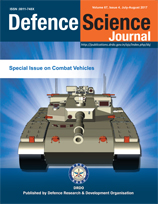Simulation of an Armoured Vehicle for Blast Loading
DOI:
https://doi.org/10.14429/dsj.67.11430Keywords:
Occupant safety, Improvised explosive device, IED, Finite element model, FEMAbstract
Occupant safety in an armoured vehicle is of paramount importance. Most serious threat to armoured vehicles comes in the form of explosion of buried charge or an improvised explosive device. The use of numerical methods in the validation process of light armoured vehicles reduces the number of prototypes required and decreases the design time. This paper elucidates the process by which one such validation using numerical methods was done. The process of finite element method used for simulation of blast is a prominent method of numerical method of simulation. The finite element model (FEM) process starts with discretisation. By discretisation or meshing, Shell (Quad/Tria) and solid (Tetra/Hexa) elements are generated. The FEM thus created is provided with relevant material model / properties and loading and boundary conditions. The loading conditions are adopted from STANAG 4569 Level II standards. Local deformation, global displacement, stresses and time history of displacement of particular areas of interest are obtained as results. Comparison results include the effect of with and without thermal softening under blast. Based on the results and comparison, suggestions regarding re-engineering the vehicle are presented.Downloads
Published
2017-06-30
How to Cite
Mahajan, S., & Muralidharan, R. (2017). Simulation of an Armoured Vehicle for Blast Loading. Defence Science Journal, 67(4), 449–453. https://doi.org/10.14429/dsj.67.11430
Issue
Section
Special Issue Papers
License
 Where otherwise noted, the Articles on this site are licensed under Creative Commons License: CC Attribution-Noncommercial-No Derivative Works 2.5 India
Where otherwise noted, the Articles on this site are licensed under Creative Commons License: CC Attribution-Noncommercial-No Derivative Works 2.5 India


